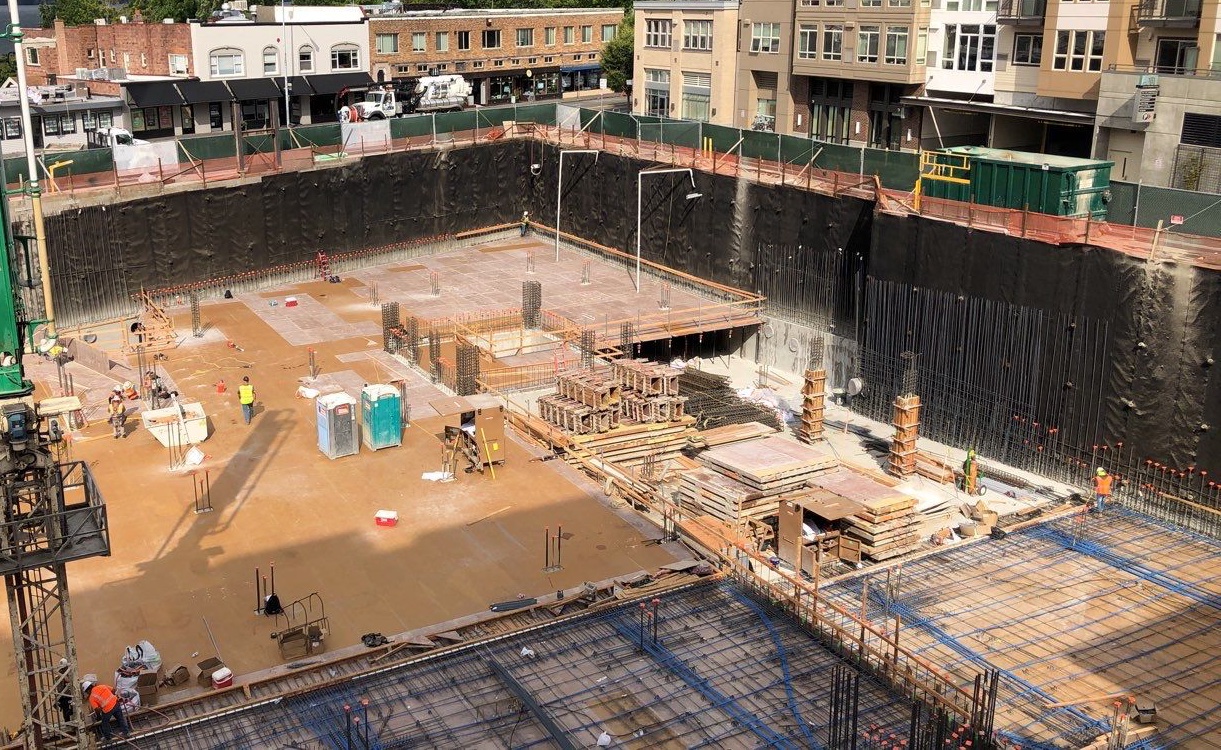
Whether you’re building a parking garage, service tunnels or any other structure that extends below the ground surface, the integrity of your below-grade waterproofing will impact the performance of the rest of the building.
So, what does proper below-grade waterproofing look like?
We’re here to show you — let’s take a look at how to ensure proper below-grade waterproofing on all of your projects.
About Below-Grade Waterproofing
To keep a foundation leak-free and safe, builders need to pair high-performing waterproofing with effective water management strategies. Below-grade waterproofing consists of coatings and membranes applied to the walls of a building’s foundation to seal and protect the rest of the space.
These applications are necessary for the integrity of a building. The Whole Building Design Guide offers insight into why, often coming down to cost-efficiency: “For most portions of the foundation wall, water removal and control is of prime importance. However, water removal measures around foundation walls below the water table may be impractical and expensive over the long-term and the waterproofing strategy becomes critical.”
Porous materials like concrete can deteriorate over time, which can create hazardous conditions if groundwater, contaminated vapor or ground gases migrate through any cracks in the building foundation. Using a barrier between the concrete and earth prevents this kind of damage from occurring.
There are two types of systems that offer solutions in below-grade applications: prefabricated sheet and fluid-applied membrane systems.
- Prefabricated sheet membrane systems can consist of bentonite, elastomeric sheets, HDPE or thermoplastic membranes.
- Fluid-applied membrane systems can be a single component, cold or hot liquid-applied, or combined with prefabricated sheet membranes to form a composite system.
Every below-grade waterproofing project has its own unique solution. For example, parking lots have different requirements than hospitals, which could require a composite waterproofing system. Depending on the size of the space you’re working in, you might not need a composite system, but something simpler and easier to install.
Choosing the Best Below-Grade Waterproofing
Waterproofing projects are their own special kind of challenge. That’s because the foundation of a building must perform under different types of pressure — quite literally.
There’s pressure from the weight of materials on top of the foundation, which must be engineered for load-bearing. The foundation is also impacted by continual hydrostatic pressure from groundwater in the surrounding area.
A few other factors will impact decisions around waterproofing a project:
- Climate conditions: temperature, precipitation and humidity
- Drainage and water management systems
- The quality of the soil around the foundation
If you’re trying to decide what kind of below-grade waterproofing will work best, it helps to know what kinds of solutions are out there and how to specify them for your project. Builders will need to know — aside from their budget and timeline — the size of the building, its occupancy status, local building code requirements, the type of soil around the foundation and any previous products used.
A geotechnical report will determine the water table level and presence of hydrostatic pressure or perched water. Project managers will also want to see if any environmental testing indicates ground gases or contamination. From there, you can narrow down the best waterproofing solutions for your project.
Waterproofing Systems That Work

Large commercial projects come with complications, but the right waterproofing system can protect the integrity of the project. There are a few types of below-grade products to consider:
- Blind-side or pre-applied membranes are installed on the outside of the wall or foundation. This is installed before the wall is built, so it can be a challenge to apply on some projects.
- Positive-side waterproofing is applied after the wall is up and requires access to the outside of the building.
- Negative-side waterproofing is applied to the inside of the building and isn’t always reliable, but will offer protection if the outside face of the building isn’t accessible.
To keep out contaminated groundwater, find a product that stops vapor intrusion and water infiltration.
A composite waterproofing system uses a variety of these products to keep groundwater, contaminants and organic solvents out of the building, all in one efficient system.
Today’s Solutions for High-Performance Waterproofing
Every waterproofing job looks different, but EPRO has more than 30 years of experience and installed millions of square feet of waterproofing solutions. Our methods of waterproofing, including below-grade waterproofing, can save your building from foundation damage, indoor health issues and high energy bills.
When you work with a manufacturer committed to the success of your project, you can rest easy. From site conditions to budget requirements, EPRO will work with builders and contractors to find the most ideal waterproofing system for your job, without compromising your budget.
Our proven method of waterproofing has helped builders and contractors everywhere find solutions for their projects. Need more tips and best practices? Learn more here.
